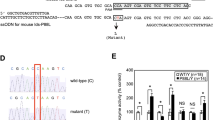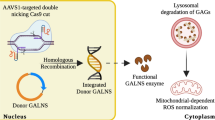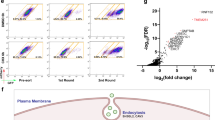Abstract
Mucolipidosis II (ML II) is a fatal lysosomal storage disorder resulting from defects in the multimeric GlcNAc-1-phosphotransferase responsible for the initial step in the generation of the mannose 6-phosphate (M6P) recognition marker1. M6P residues on oligosaccharides of newly synthesized lysosomal enzymes are essential for efficient receptor-mediated transport to lysosomes2. We used the recombinant GlcNAc-1-phosphotransferase γ subunit as an affinity matrix to purify an unknown protein identified as the product of GNPTA (encoding GNPTA, previously known as MGC4170). The cDNA encodes a protein of 1,256 amino acids with two putative transmembrane domains and a complex preserved modular structure comprising at least six domains. The N-terminal domain of GNPTA, interrupted by a long insertion, shows similarities to bacterial capsule biosynthesis proteins. We identified seven mutations in GNPTA that lead to premature translational termination in six individuals with ML II. Retroviral transduction of fibroblasts from an individual with ML II resulted in the expression and localization of GNPTA in the Golgi apparatus, accompanied by the correction of hypersecretion of lysosomal enzymes. Our results provide evidence that GNPTA encodes a subunit of GlcNAc-1-phosphotransferase defective in individuals with ML II.
This is a preview of subscription content, access via your institution
Access options
Subscribe to this journal
Receive 12 print issues and online access
$209.00 per year
only $17.42 per issue
Buy this article
- Purchase on Springer Link
- Instant access to full article PDF
Prices may be subject to local taxes which are calculated during checkout



Similar content being viewed by others
Accession codes
Accessions
BINDPlus
GenBank/EMBL/DDBJ
References
Kornfeld, S. & Sly, W.S. I–Cell Disease and Pseudo-Hurler Polydystrophy: Disorders of Lysosomal Enzyme Phosphorylation and Localization. in The Metabolic and Molecular Bases of Inherited Disease (ed. Scriver, C.R., Beaudet, A.L., Sly, W.S. and Valle, D.) 3421–3452 (McGraw-Hill, New York, 2001).
Storch, S. & Braulke, T. Transport of lysosomal enzymes. in Lysosomes (ed. Saftig, P.) 17–26 (Eurekah, Landes Bioscience, Springer & Business Media, New York, 2005).
Bao, M., Booth, J.L., Elemendorf, B.J. & Canfield, W.M. Bovine UDP-N-acetylglucosamine:lysosomal-enzyme N-acetylglucosamine-1-phosphotransferase. I. Purification and subunit structure. J. Biol. Chem. 271, 31437–31445 (1996).
Paik, K.H. et al. Identification of mutations in the GNPTA (MGC4170) gene coding for GlcNAc-phosphotransferase alpha/beta subunits in Korean patients with mucolipidosis type II or type IIIA. Hum. Mutat. 26, 308–314 (2005).
Raas-Rothschild, A. et al. Molecular basis of variant pseudo-hurler polydystrophy (mucolipidosis IIIC). J. Clin. Invest. 105, 673–681 (2000).
Tiede, S. et al. A novel mutation in UDP-N-acetylglucosamine-1-phosphotransferase gamma subunit (GNPTAG) in two siblings with mucolipidosis type III alters a used glycosylation site. Hum. Mutat. 24, 535 (2004).
Raas-Rothschild, A. et al. Genomic organisation of the UDP-N-acetylglucosamine-1-phosphotransferase gamma subunit (GNPTAG) and its mutations in mucolipidosis III. J. Med. Genet. 41, e52 (2004).
Eckert, V. et al. Cloning and functional expression of the human GlcNAc-1-P transferase, the enzyme for the committed step of the dolichol cycle, by heterologous complementation in Saccharomyces cerevisiae. Glycobiology 8, 77–85 (1998).
Tzeng, Y.L., Noble, C. & Stephens, D.S. Genetic basis for biosynthesis of the (alpha 1 → 4)-linked N-acetyl-D-glucosamine 1-phosphate capsule of Neisseria meningitidis serogroup X. Infect. Immun. 71, 6712–6720 (2003).
Pohlmann, R., Waheed, A., Hasilik, A. & von Figura, K. Synthesis of phosphorylated recognition marker in lysosomal enzymes is located in the cis part of Golgi apparatus. J. Biol. Chem. 257, 5323–5325 (1982).
Hasilik, A. & Neufeld, E. Biosynthesis of lysosomal enzymes in fibroblasts. Synthesis as precursors of higher molecular weight. J. Biol. Chem. 255, 4937–4945 (1980).
Riederer, M.A., Soldati, T., Shapiro, A.D., Lin, J. & Pfeffer, S.R. Lysosome biogenesis requires Rab9 function and receptor recycling from endosomes to the trans-Golgi network. J. Cell Biol. 125, 573–582 (1994).
Lübke, T. et al. Complementation cloning identifies CDG-IIc, a new type of congenital disorders of glycosylation, as a GDP-fucose transporter deficiency. Nat. Genet. 28, 73–76 (2001).
Storch, S., Pohl, S. & Braulke, T. A dileucine motif and a cluster of acidic amino acids in the second cytoplasmic domain of the batten disease-related CLN3 protein are required for efficient lysosomal targeting. J. Biol. Chem. 279, 53625–53634 (2004).
Muschol, N. et al. Secretion of phosphomannosyl-deficient arylsulphatase A and cathepsin D from isolated human macrophages. Biochem. J. 368, 845–853 (2002).
Acknowledgements
This study was supported by Deutsche Forschungsgemeinschaft (GRK464 to S.T. and SFB470/C6 to T.B.). We thank K. von Figura (University of Göttingen) and M. Cantz (University of Heidelberg) for the cultured fibroblasts from ML II patients (Z.B., M.A. and R.D., respectively).
Author information
Authors and Affiliations
Corresponding author
Ethics declarations
Competing interests
The authors declare no competing financial interests.
Supplementary information
Supplementary Fig. 1
Nucleotide sequence and deduced amino acid sequence of human MGC4170. (PDF 301 kb)
Supplementary Fig. 2
Domain organization of human MGC4170 and comparison with Drosophila melanogaster CG8027, Dictyostelium discoideum AAO52495, Entamoeba histolytica EAL52006, Mycobacterium tuberculosis CpsY, and Neisseria meningitides XcbA. (PDF 16 kb)
Rights and permissions
About this article
Cite this article
Tiede, S., Storch, S., Lübke, T. et al. Mucolipidosis II is caused by mutations in GNPTA encoding the α/β GlcNAc-1-phosphotransferase. Nat Med 11, 1109–1112 (2005). https://doi.org/10.1038/nm1305
Received:
Accepted:
Published:
Issue Date:
DOI: https://doi.org/10.1038/nm1305
This article is cited by
-
Transgenic inhibition of interleukin-6 trans-signaling does not prevent skeletal pathologies in mucolipidosis type II mice
Scientific Reports (2021)
-
Mucolipidosis type II and type III: a systematic review of 843 published cases
Genetics in Medicine (2021)
-
Clinical, radiological and computational studies on two novel GNPTG variants causing mucolipidosis III gamma phenotypes with varying severity
Molecular Biology Reports (2021)
-
Whole exome sequencing uncovered highly penetrant recessive mutations for a spectrum of rare genetic pediatric diseases in Bangladesh
npj Genomic Medicine (2021)
-
B-cell-specific accumulation of inclusion bodies loaded with HLA class II molecules in patients with mucolipidosis II (I-cell disease)
Pediatric Research (2019)



